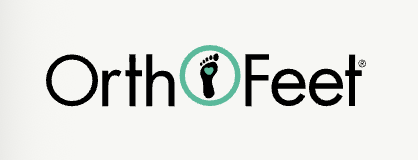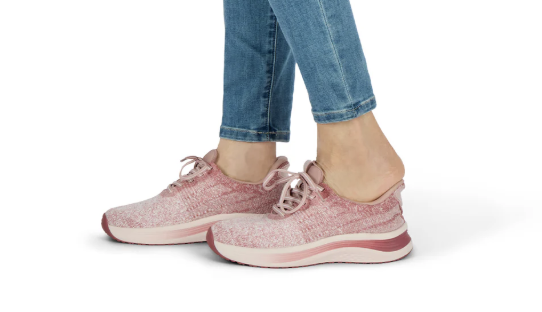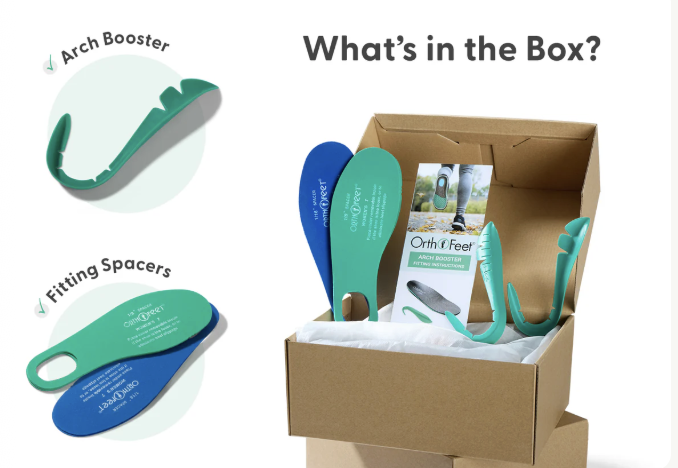Footwear Focus—A Podiatrist Reviews Orthofeet Sneakers
As a podiatrist, runner, and active person, I firmly believe that the right footwear is one of the most important investments you can make in your long-term health and wellness.
Your feet are literally your touchpoint with the Earth, and focusing on their safety, support, and stability lays the foundation you need to nurture your health from the ground up.
Helping my patients to make smart, informed footwear choices is why I started this Footwear Focus series—to highlight brands with thoughtful design, real support, and features that actually make a difference for real people dealing with foot pain.
This month, I’m taking a closer look at Orthofeet, a brand that’s been on my radar for years and often comes up in conversations with patients looking for relief from conditions like plantar fasciitis, bunions, hammertoes, and diabetic neuropathy.
As always, in addition to my firsthand review of their offerings, I’ll also share a deep dive into the brand’s approach to footwear, what makes them stand out, and what patients and professionals are saying about them.
So you can choose with confidence and clarity if Orthofeet sneakers deserve a coveted spot in your footwear rotation.
Let’s get moving!
Orthofeet brand overview
Orthofeet was founded in 1985 by two biomechanical engineer brothers who wanted to design footwear that offered true orthopedic support without sacrificing comfort.
The brand focuses on therapeutic shoes for people with a wide range of foot issues, including plantar fasciitis, flat feet, arthritis, diabetes, and bunions.
Their tagline is “pain-free walking,” and they build everything around this mission.
The brand frequently mentions how they’re widely approved by podiatrists, and share several unique features that set their footwear apart from the competition.
Their shoes are designed with medical-grade support features, including anatomical arch support, cushioned soles, and roomy, non-binding uppers that reduce friction and pressure on the feet.
Their website even offers a search tool that allows you to explore styles based on both specific footwear categories and foot and ankle conditions. It’s a pretty cool way to lean into user experience and help customers find exactly the right options for their foot health needs.
Whether it’s a walking shoe, sneaker, sandal, or even a slipper, Orthofeet works to keep its design principles consistent across its product line.
What makes Orthofeet different?
One thing I appreciate about Orthofeet’s philosophy is that they’re not trying to reinvent fashion—they’re prioritizing function. And that’s not a bad thing when your priority is pain relief.
One of the standout features across their lineup is the Orthofeet Ortho-Cushion™ System.
This includes an ergonomic sole with a mild rocker design, a premium orthotic insole with arch support and a deep heel cup, and shock-absorbing cushioning in the midsole and heel. The goal is to reduce pressure underfoot and promote better alignment from the ground up.
Another feature I appreciate is their removable fitting spacers. These small inserts are included with many Orthofeet shoes, allowing wearers to customize the internal volume of the shoe.
This is especially helpful if you wear custom orthotics, have one foot slightly larger than the other, or experience regular swelling.
Most of their shoes also come with seam-free, padded interiors to reduce irritation, friction, and rubbing, which is essential for anyone dealing with diabetes, neuropathy, or simply sensitive skin that’s prone to blisters or calluses.
Orthofeet also offers a range of widths and generous toe boxes, which is something I personally appreciate and look for to recommend to my patients.
This dynamic combination of depth, width, and adjustability makes Orthofeet a great option for feet that need a little extra room, whether due to bunions, hammertoes, or swelling.
What podiatrists and customers say about Orthofeet
Before I share my personal review of a footwear brand or style, I like to assess and share the broader narrative around the company and its offerings.
I dig into what other podiatrists and wearers have to share about the brand to discover how the shows perform in real-world settings, and explore what people say once they’ve had them on their feet for a while.
Orthofeet consistently comes up online among professionals who treat patients with chronic foot pain, diabetes, or structural foot deformities.
Many podiatrists recommend Orthofeet as a reliable therapeutic option—especially for patients who need extra depth, soft uppers, or accommodative footwear for custom orthotics.
The brand has been recommended in clinical settings for conditions like plantar fasciitis, neuropathy, arthritis, and bunions. In this respect, the shoes check a lot of boxes: supportive, cushioned, customizable, and built with medical needs in mind.
What stands out in most professional reviews is Orthofeet’s combination of structural support and comfort.
The brand’s orthotic insoles are often praised by podiatrists for how well they align the foot and reduce heel and midfoot strain. The extra-wide toe boxes, seam-free interiors, and stretchable uppers are also frequently highlighted by clinicians treating patients with forefoot deformities or hypersensitive skin.
I’ve also seen Orthofeet listed in podiatrist-approved guides for best shoes for flat feet, heel pain, and even hands-free accessibility—particularly models like the Kita and Coral, which are designed for ease of wear and everyday comfort.
That said, it’s important to remember that not every shoe works for every foot.
Some podiatrists note that Orthofeet’s shoes can run a little heavy or bulky, depending on the model. They’re also not the sleekest option on the market, and certain styles may not be the best choice for high-activity needs. Durability varies as well; while some shoes hold up beautifully, others may show wear after daily, high-mileage use.
Fit can also be a bit inconsistent across Orthofeet styles. Because many of their shoes are built to accommodate swelling, orthotics, or foot deformities, wearers may need to try more than one size or width to get the right fit.
Luckily, Orthofeet offers a 60-day wear test, which gives some peace of mind during this trial-and-error process.
Overall, the professional consensus seems clear: Orthofeet fills an important gap in the market for medical-grade, comfort-focused shoes that are designed to work with—not against—the realities of foot pain.
For many podiatrists, it’s a go-to recommendation when traditional footwear just doesn’t cut it anymore.
Now that you know what others are saying, let’s dive into my personal experience with the brand and my review of Orthofeet sneakers.
Dr. Young’s review of Orthofeet sneakers
From a clinical standpoint, I appreciate how Orthofeet considers what people with foot pain need, makes intentional design choices that reflect that, and offers options to deliver comfort to those in need.
For my review and trial, I opted for the Nira sneaker in red. I chose this style because it seemed to have a higher level of cushioning than others, and I wanted sneakers to wear with my scrubs on my daily commute and throughout the workday.
I also really like the look of these. They’re simple and clean and not visibly branded.
One thing I noticed and appreciated first was how these arrived with a lot of extra goodies. They came with two different inserts of varying thickness you can use to take up more room in the shoe for a better fit if they’re too wide or big. They also came with little plastic pieces they call “arch boosters” which you can use to add more support.
I tried out the arch boosters and could definitely feel a difference. Ultimately, they weren’t right for me, but I can see how they might benefit others.
These are billed as hands-free, and, while it is possible to take them on and off without using your hands, the laces do need to be retied intermittently when they grow too loose.
One feature I found especially interesting about these is the tongue of the shoe. It’s significantly more attached to the side of the shoe on the medial (inside) part than the lateral (outside). I assume this is to make it more secure on the inside, where the arch is, but also keep it flexible enough to get on and off hands-free. When I had the arch boosters in, I felt like the lateral seam rubbed on my ankle a bit. I couldn’t find info about this from the brand, but wanted to point it out.
These are also billed as having a wide toe box and some stretch, which I found to be accurate. While they don’t have the widest toe box I’ve seen, it’s pretty accommodating.
They say you can run in these, but I would personally be hesitant to do so. The drop is far too high at 14.7mm versus my typical running shoes, so it could lead to issues if you’re not used to this.
My overall verdict?
These are really comfortable shoes, and I’ve walked in them a TON with no issues with foot pain or fatigue. I consider myself a big fan and have been wearing these nearly every day. I’d definitely recommend them to my patients, and I may even try out some of their non-sneaker options for myself in the future to see what else they have to offer.
Reach out if you’ve got a footwear brand you’d like me to review next, and check out my other Footwear Focus blogs! Get in touch, stop by the office, or book your appointment easily online for your personalized, expert footwear recommendations.
City Step Podiatry is here for you! Reach out today to schedule your visit and treat your feet to the care they deserve.









